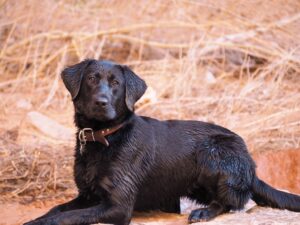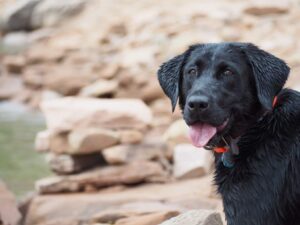Teaching “stay” is just proofing a known obedience cue for duration. This article covers the very first steps of teaching duration in behavior, navigating the cues around “stay”, and exploring the differences between implied and explicit stays.
Choose Your Adventure: Implied vs Explicit Stays
Implied Stays
In dog sports and in many working dog fields, there is only one kind of stay – the implied stay. This means that when a handler says “Sit!” that means “Sit until further instructed” – a sit stay. The “stay” is implied in the “sit”. In the competitive sport world, saying “stay” usually results in deductions due to extra cues.
Implied stays are very valuable for working efficiently – you don’t have to remember to cue a “stay” and you don’t have to worry about what your dog is doing if you don’t have your eyes on them. Your dog is also not confused about if “stay” means “sit and stay put” or “down and stay put” or just “stay put”.
The cost of implied stays is that if you want to keep them strong, you have to follow the main rule of “stay” all the time – remember to give your release cue.
Explicit Stays
In the companion dog world, explicit stays are much more common. Owners often say “Stay!” explicitly. If you ask your dog to sit or down fairly frequently without needing them to stay there, or if you have young kids who want to work with your dog and are likely to forget the release cue – explicit stays are a good option.
The drawbacks are that sometimes dogs have trouble grasping that “stay” means “don’t move from this spot” – it is easier for them to understand the difference between sitting and laying down, and often they categorize “stay” to just be a word for “sit….for a while” (or “down….for a while”) rather than interchangeable between the two.
How to Teach Stay
- Grab a handful of treats – at least 5.
- Ask your dog for a behavior they already know – like sit or down.
- Lure them into position, so the food is right in front of their face. As soon as they are in position, start feeding treats.
- As long as they stay in position, feed them treats one at a time!
- If they get up, stop rewarding. Ask them to get back in position and begin feeding as soon as they do.
- Before you run out of treats, say “Free!” and toss a cookie for them.
- Repeat.
- As you progress, start stretching the time between treats slightly – always at a rate where they don’t break position. If they do break position, reset them and reward a little faster.
- Repeat like this until you can go 3-4 seconds between treats.
- (Optional: Add the cue. Next round, say “Sit!” then “Stay!” as soon as they are sitting, feeding immediately. Repeat a few times.)
- Now you’re ready for proofing!
Tips & Troubleshooting
- Like all important behaviors, don’t ask for it unless you’re willing to bet $20 on it’s success. Stay is an essential safety behavior, which means we need to take it seriously. Don’t weaken your training by asking for it when you know your dog won’t be able to do it.
- Make sure to practice in all the positions you want to add duration to.
- Some behaviors can have implied stays while others have explicit stays. Consistency is important – but only matters within one behavior. So, don’t worry if you always say “Stay!” with sit and never say it with down. It’s only a problem if your dog can’t predict if you’re saying “Stay!” for a given behavior one day and not saying it on another.
- If you want your dog to stay calmly and not be prone to breaking his stay out of anticipation, return to your dog before you say “Free!” to reduce his anticipation.
- If you want your dog to stay and maintain rapt attention on you (or on a reinforcer in the environment), release your dog to a high value reinforcer when you are some distance away from him – and release him at random intervals. He will associate the feelings of sprinting for his toy/food with the stay behavior, and be ready to bolt at a moment’s notice. Not usually useful for companion dogs, but makes for very flashy performance dogs!



